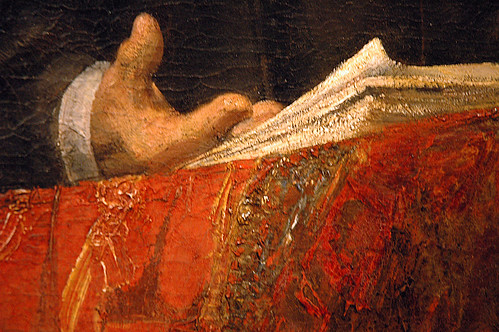Yesterday was the museum day for us. We awoke late and had a wonderful breakfast (with bacon!) and set out for the Van Gogh Museum. The last time I saw a major collection of Van Gogh work was in Los Angeles in 1999. That show was a good one, but seeing his work here was more intense. I was particularly please with the collection of Van Gogh studies the museum grouped together. I think every person who devotes themselves to creating stuff has a time or two when the neuroses kick in and one asks the hard questions about the work, the relevancy, etc. Vincent took it to extremes, to be sure, but all artistic types suffer at one time or another for their work. The museum had some nice groupings of portraits of Van Gogh by Gaugin and others.
After a brief bio-break, we headed out again to the Rijksmuseum (warning, lots of JSP and Flash pages), excited to see some works of Rembrandt, Hals and Vermeer. We weren’t disappointed. The Rijksmuseum is undergoing major renovation, but they have an outstanding collection of antiquities and a wide range of work that dates back several hundred years. Of course, it’s Rembrandt’s 400th birthday this year, so there were a few galleries devoted to him. Night Watch is really stunning. It’s much larger in real life that I had imagined. The figures are almost life-sized.
I remember an art history professor talking about seeing the work first hand and how the slides can’t give a sense of depth that you get upon seeing a painting up close in the real.
A good example of what my art history professor was talking about can be seen in a detail of The Sampling Officials (The Draper’s Guild):

(click image for larger versions on flickr)
and the Self-Portrait as the Apostle Paul:

(click image for larger versions on flickr)
The amount of paint and the brush strokes add such a depth to the image that you’d never get from a photo. These detailed shots are not so good, so I apologize for the blurry quality. The idea is that Rembrandt is throwing a lot of paint on the canvas that gives it a texture that’s extra-dimensional. And until you walk up to the canvas and see it, those details are lost.
I was moved by the realistic works of other artists (e.g., Abraham von Beyeren). Some of the paintings of grapes and glass and reflective surfaces are insanely detailed, and not until you are right on top of the canvas can you begin to see brush strokes. It’s scary how much control these artists had. Seeing this work prompted Heather to ask rhetorically, “Can artists today even come close to this in skill and detail?”
“I’m sure that kind of skill is out there, but who would commission work of that kind in today’s world?”
And then we exploded from pomposity.
